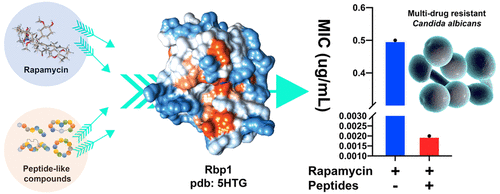当前位置:
X-MOL 学术
›
ACS Infect. Dis.
›
论文详情
Our official English website, www.x-mol.net, welcomes your
feedback! (Note: you will need to create a separate account there.)
Hyper-Synergistic Antifungal Activity of Rapamycin and Peptide-Like Compounds against Candida albicans Orthogonally via Tor1 Kinase
ACS Infectious Diseases ( IF 4.0 ) Pub Date : 2021-09-13 , DOI: 10.1021/acsinfecdis.1c00448 Yaojun Tong 1, 2 , Jingyu Zhang 3 , Luoqiang Wang 4, 5 , Qinqin Wang 4 , Huang Huang 1 , Xiangyin Chen 3 , Qing Zhang 3 , Hantian Li 1 , Nuo Sun 6 , Guang Liu 3 , Buchang Zhang 5 , Fuhang Song 4 , Gil Alterovitz 7 , Huanqin Dai 1 , Lixin Zhang 3
ACS Infectious Diseases ( IF 4.0 ) Pub Date : 2021-09-13 , DOI: 10.1021/acsinfecdis.1c00448 Yaojun Tong 1, 2 , Jingyu Zhang 3 , Luoqiang Wang 4, 5 , Qinqin Wang 4 , Huang Huang 1 , Xiangyin Chen 3 , Qing Zhang 3 , Hantian Li 1 , Nuo Sun 6 , Guang Liu 3 , Buchang Zhang 5 , Fuhang Song 4 , Gil Alterovitz 7 , Huanqin Dai 1 , Lixin Zhang 3
Affiliation

|
Candida albicans is a life-threatening, opportunistic fungal pathogen with a high mortality rate, especially within the immunocompromised populations. Multidrug resistance combined with limited antifungal drugs even worsens the situation. Given the facts that the current drug discovery strategies fail to deliver sufficient antifungals for the emerging multidrug resistance, we urgently need to develop novel approaches. By systematically investigating what caused the different antifungal activity of rapamycin in RPMI 1640 and YPD, we discovered that peptide-like compounds can generate a hyper-synergistic antifungal effect with rapamycin on both azole-resistant and sensitive clinical C. albicans isolates. The minimum inhibitory concentration (MIC) of rapamycin reaches as low as 2.14 nM (2–9 μg/mL), distinguishing this drug combination as a hyper-synergism by having a fractional inhibitory concentration (FIC) index ≤ 0.05 from the traditional defined synergism with an FIC index < 0.5. Further studies reveal that this hyper-synergism orthogonally targets the protein Tor1 and affects the TOR signaling pathway in C. albicans, very likely without crosstalk to the stress response, Ras/cAMP/PKA, or calcineurin signaling pathways. These results lead to a novel strategy of controlling drug resistant C. albicans infection in the immunocompromised populations. Instead of prophylactically administering other antifungals with undesirable side-effects for extended durations, we now only need to coadminister some nontoxic peptide additives. The novel antifungal strategy approached in this study not only provides a new therapeutic method to control fungal infections in rapamycin-taking immunocompromised patients but also mitigates the immunosuppressive side-effects of rapamycin, repurposing rapamycin as an antifungal agent with wide applications.
中文翻译:

雷帕霉素和肽样化合物通过 Tor1 激酶正交抗白色念珠菌的超协同抗真菌活性
白色念珠菌是一种危及生命的机会性真菌病原体,死亡率很高,尤其是在免疫功能低下的人群中。多药耐药性加上有限的抗真菌药物甚至使情况恶化。鉴于当前的药物发现策略无法为新出现的多药耐药性提供足够的抗真菌药物,我们迫切需要开发新的方法。通过系统研究导致 RPMI 1640 和 YPD 中雷帕霉素不同抗真菌活性的原因,我们发现肽类化合物可以与雷帕霉素对唑类耐药和敏感的临床白色念珠菌分离物产生超协同抗真菌作用。雷帕霉素的最小抑菌浓度 (MIC) 低至 2.14 nM (2–9 μg/mL),通过抑制浓度分数 (FIC) 指数 ≤ 0.05 与 FIC 指数 < 0.5 的传统定义协同作用,将此药物组合区分为超协同作用。进一步的研究表明,这种超协同作用正交地靶向蛋白质 Tor1 并影响白色念珠菌中的 TOR 信号通路,很可能与应激反应、Ras/cAMP/PKA 或钙调神经磷酸酶信号通路没有串扰。这些结果导致了控制耐药性白色念珠菌的新策略免疫功能低下人群的感染。我们现在不需要长期预防性地使用其他具有不良副作用的抗真菌药,而只需要共同使用一些无毒的肽添加剂。本研究中采用的新型抗真菌策略不仅提供了一种新的治疗方法来控制服用雷帕霉素的免疫功能低下患者的真菌感染,而且还减轻了雷帕霉素的免疫抑制副作用,将雷帕霉素重新用作具有广泛应用的抗真菌剂。
更新日期:2021-10-08
中文翻译:

雷帕霉素和肽样化合物通过 Tor1 激酶正交抗白色念珠菌的超协同抗真菌活性
白色念珠菌是一种危及生命的机会性真菌病原体,死亡率很高,尤其是在免疫功能低下的人群中。多药耐药性加上有限的抗真菌药物甚至使情况恶化。鉴于当前的药物发现策略无法为新出现的多药耐药性提供足够的抗真菌药物,我们迫切需要开发新的方法。通过系统研究导致 RPMI 1640 和 YPD 中雷帕霉素不同抗真菌活性的原因,我们发现肽类化合物可以与雷帕霉素对唑类耐药和敏感的临床白色念珠菌分离物产生超协同抗真菌作用。雷帕霉素的最小抑菌浓度 (MIC) 低至 2.14 nM (2–9 μg/mL),通过抑制浓度分数 (FIC) 指数 ≤ 0.05 与 FIC 指数 < 0.5 的传统定义协同作用,将此药物组合区分为超协同作用。进一步的研究表明,这种超协同作用正交地靶向蛋白质 Tor1 并影响白色念珠菌中的 TOR 信号通路,很可能与应激反应、Ras/cAMP/PKA 或钙调神经磷酸酶信号通路没有串扰。这些结果导致了控制耐药性白色念珠菌的新策略免疫功能低下人群的感染。我们现在不需要长期预防性地使用其他具有不良副作用的抗真菌药,而只需要共同使用一些无毒的肽添加剂。本研究中采用的新型抗真菌策略不仅提供了一种新的治疗方法来控制服用雷帕霉素的免疫功能低下患者的真菌感染,而且还减轻了雷帕霉素的免疫抑制副作用,将雷帕霉素重新用作具有广泛应用的抗真菌剂。











































 京公网安备 11010802027423号
京公网安备 11010802027423号